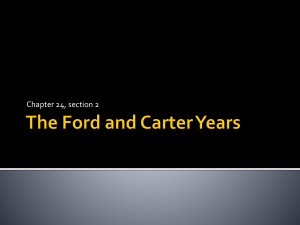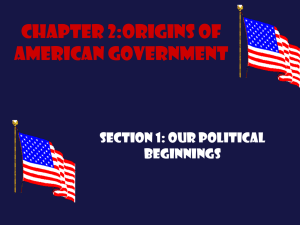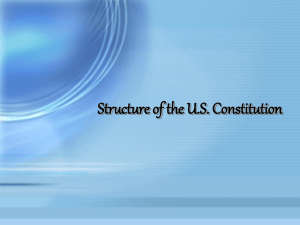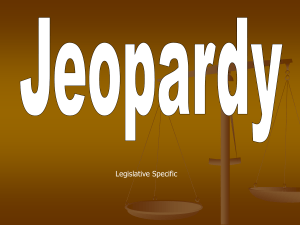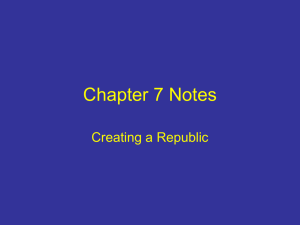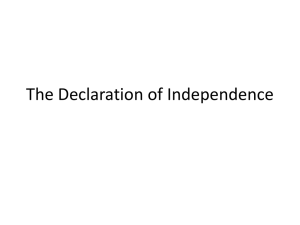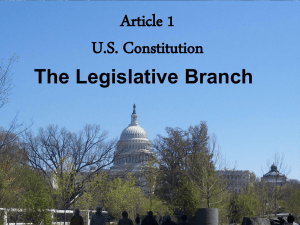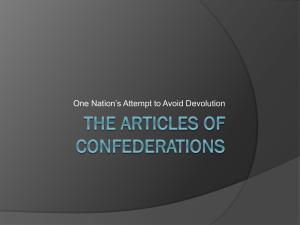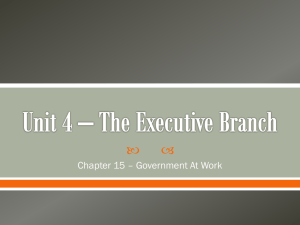English settlers brought knowledge of political
advertisement
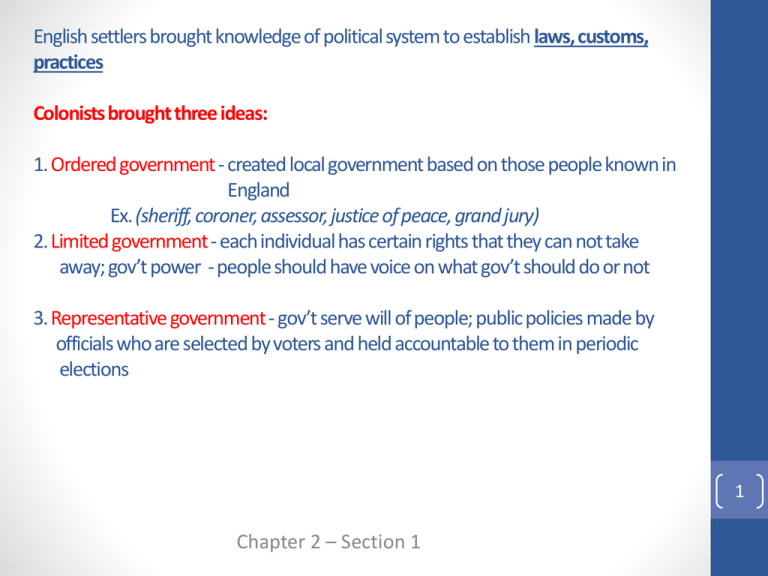
English settlers brought knowledge of political system to establish laws, customs, practices Colonists brought three ideas: 1. Ordered government - created local government based on those people known in England Ex. (sheriff, coroner, assessor, justice of peace, grand jury) 2. Limited government - each individual has certain rights that they can not take away; gov’t power - people should have voice on what gov’t should do or not 3. Representative government - gov’t serve will of people; public policies made by officials who are selected by voters and held accountable to them in periodic elections 1 Chapter 2 – Section 1 3 Documents 1215 - Magna Carta “Great Charter” (King John forced to sign) Charter establishing the principle power of monarchy is NOT absolute Protecting people’s rights like; trial by jury; due process of law; protection against arbitrarily taking life, liberty or property. 1628 - Petition of Right - Challenged Divine Right of King – Monarch must obey law of land -Limited king’s power by not allowing king to imprison political critics without trial by jury -Not rule by military during peacetime and not have to shelter troops with consent - THIS WAS ONLY A PETITION, NOT A LIST OF DEMANDS. King needed money to fight a war with France so agreed to it until he got the money and then abused his authority. 1689 - English Bill of Rights -written by Parliament to prevent abuse of power by English monarchs -Monarchs had to follow the laws of Parliament -Citizens had a right to petition to the gov’t and vote for members of Parliament -Prohibited standing army in peacetime except with consent of Parliament -guaranteed rights to a fair & speedy trial, freedom from excessive bail, cruel and unusual punishment. Chapter 2 – Section 1 2 Three different kinds of colonies 1. Royal Colony (NH, NY, NJ, VA, NC, SC, GA, MA)- subject to direct control of crown. -King named governor and a council. -Legislature is bicameral = 2 houses -Council became Upper house in legislature and highest court in colony. -Lower house = legislators elected by those property owners who vote shared with governor’s power = (power of the purse) tax & spending. -Laws passed had to be approved by Governor and King 2. Proprietary Colony (MD, PA, DE) - 3 colonies; PA-unicameral; MD, DE – bicameral Proprietor - a person the king made a grant of land. By charter, land could be governed and settled to his choosing; MD = granted to Lord Baltimore; PA, DE = William Penn; Governor appointed by proprietor. 3. Charter Colony - CT, RI MASS BAY = 1st - self governed by colonists. -Governors elected yearly by male property owners. -Used a bicameral system. -Laws made are not subject to governor’s veto or king’s approval. -Judges appointed by legislature; Appeals to law could be taken to king Chapter 2 – Section 1 3 1643 - Mass, Plymouth, New Haven, Connecticut = New England Confederation formed a “league of friendship” (joining of several groups for a common purpose) to defend against American Indians; Dissolved 1684 1754 - Albany Plan of Union British Board of Trade had meeting with 7 northern colonies to discuss colonial trade and dangers of attack by French & Indians Benjamin Franklin proposed the ALBANY PLAN OF UNION = formation of annual Congress with delegates from 13 colonies. Body would have power to: raise military and armed forces, make war and peace with Native Americans, regulate trade, levy tax, collect custom duties, it was agreed by delegates but denied by colonies and rejected by Crown. 1760 - George III began to create restrictive trading acts and enforcing new taxes to support the British troops in America SUGAR ACT – tax on foreign-made molasses Colonists objected to taxes “taxation w/o representation” Saw little need for the costly presence of British troops since French were defeated (Fr./Indian War 1754-63) Colonist refused to accept Parliament had a right to control their local affairs. Chapter 2 – Section 2 4 1765 - Stamp Act Parliament passed new laws; use of tax stamps on all legal documents, business agreements, newspapers; rates were severe and colonists were made b/c of “taxation w/o representation”; Delegates from 9 colonies sent reps to Stamp Act Congress - NY and prepared a strong protest. Parliament repealed the Stamp Act; but made new laws that were stricter. 1765 – 9 colonies came together and wrote the Declaration of Rights and Grievances to the King- protesting Britains’ colonial policies and agreed to boycott British products. 1767 – Townshend Act – taxed goods that were imported into the colony from Britain such as: lead, glass, paint, paper 1770 - Mob violence erupted at port, boycotts of English goods. British troops in Boston fired on crowd killing 5 including Crispus Attucks, a runaway slave ?= Boston Massacre 1773 Tea Act was created to save the British East India Co. sell tea to colonist tax free which would have cut out colonial merchants out of the tea trade. Colonist protested Chapter 2 – Section 2 5 1773 - Boston Tea Party - group of men disguised as Native Americans boarded 3 ships in Boston Harbor dumped East India’s tea in the water Colonist boycotted English goods 1774 - 56 delegates - 1st Continental Congress met in Philly to discuss plan of action. Created and wrote the Declaration of Rights to the King- protesting Britains’ colonial policies and agreed to boycott British products. 1st time colonies joined together to oppose the Parliament 1774 - Parliament passed more laws to punish colonist in Boston - Intolerable Acts April 19, 1775 - Revolution had begun - “shot heard around the world” - Battles of Lexington/Concord May 10, 1775 - 2nd Continental Congress met in Philly Each 13 colonies sent representatives to discuss independence. Hancock chosen President of Congress Washington appointed Commander Chief of the Continental Army Thomas Jefferson took Washington’s place - VA delegate Chapter 2 – Section 2 6 1775 , June– Battle of Bunker Hill; colonist defeated 1775, July – Continental Congress sent the king Olive Branch Petition = to have peace between colonist and Britain; King refused 1776 - Became nation’s first national gov’t - Declaration of Independence Describes the basic rights on which nation was founded Congress named the committee of five = Franklin, J. Adams, R. Sherman, R. Livingston, T. Jefferson Declaration of Independence mostly written by Thomas Jefferson July 4, 1776 - NH replaced royal charter with constitution def: Constitution - bodies of fundamental laws setting out the principles, structures, and processes of their gov’ts. 1776-77 most states drafted their own constitutions Chapter 2 – Section 2 7 Common Principles (Features )of States Constitutions 1. Popular Sovereignty - gov’t exist only with consent of the governed (people hold power & are sovereign) 2. Limited Gov’t 3. Civil Rights & liberties - sovereign people had certain rights gov’t must respect; some had bill of rights. 4. Checks and Balances AND Separation of Powers 8 Chapter 2 – Section 2 Articles of Confederation ( A of C ) – approved November, 1777 STRUCTURE of the Articles of Confederation is: -unicameral (1 vote for each state regardless of size or wealth) -executive and judicial function handled by committee in Congress -President of Congress chosen by legislature annually. Act as presiding officer. -Delegates from each state elected annually. Strengths of the A of C make war, peace and treaties send and receive ambassadors set up a money system establish a post offices build a navy and raise an army - (asking states for troops) fix uniform standards of weights and measures settle disputes among the states 9 Chapter 2 – Section 3 Weaknesses of the A of C 1 vote for each state regardless size no power to tax must borrow money from states no power to regulate between states and foreign commerce could not force states to obey A of C 9/13 states to consent to action Articles could be amended only with unanimous consent (all 13 colonies) no executive to enforce acts of Congress no national court system Obligations of the States -Pledged to obey A of C and Acts of Congress -States would provide funds & troops requested by Congress -treat citizens of other states FAIRLY & EQUALLY -give FULL FAITH & CREDIT to public acts, records, and judicial proceedings of every other State. -States agreed to surrender fugitives from justice to one another -allow open travel and trade between states -responsible for protecting life & property and accountable for promoting general welfare of people. Chapter 2 – Section 3 10 Problems Facing the New Nation - The Treaty of Paris was signed. US experienced problems: no international experience Had to reestablish trade relations with foreign nations deal with financial problems Owed money to both foreign nations and to US citizens The states of the NEW NATION would soon prove to be “UNITED” in name only States competed against each other for British favor and economic advantage (ONLY TIME STATES GOT TOGETHER was Revolutionary War b/c suited their needs.) Problems with Trade US goods exported to any port in the British Empire had to be carried on British ships Hurt American shipping industry US goods that competed with British made goods were barred altogether To keep British production going - Brit. Merchants began flooding American markets with inexpensive goods that competed with similar goods made in the US Hurt US industries and couldn’t compete with a more cheaply manufactured Brit. Good. REMEDY: Establish a tariff on British goods WEAKNESS - Prevented Congress from imposing any taxes, including tariffs on imports. Individual states could levy tariffs but NOT binding on other states Chapter 2 – Section 3 11 Problems Financing the Nation US owed several huge debts - foreign gov’t: France, Holland, Spain Congress made requests from citizens for loans Each of the 13 states had own similar debts Congress had issued 4 ½ million dollars in paper money called CONTINENTAL DOLLARS No backing of money like gold created HIGH LEVELS OF INFLATION and decreasing the value of dollar States also issued money to meet debt...15 different kinds of money circulating the country - all depreciated in value REMEDY: pass a tax to raise revenue Force states to stop printing paper money WEAKNESS - nat’l gov’t had NO power to tax & NO power to enforce laws or restrictions to the states. 12 Chapter 2 – Section 3 Problems in Foreign Relations US very weak militarily Army disbanded due to lack of funds Navy borrowed ships from France US was weak and stronger countries took advantage Brit passed series of NAVAGATION ACTS - closed British West Indies ports, forbade importation of N.England fish, levied taxes on American ships in other British ports Spain closed the Mississippi River and port of New Orleans to American Shipping. States continued to hold British citizens’ property - violation of the Treaty of Paris Britain kept troops stationed in forts along the frontier to harass American settlers coming across the Appalachian Mts. US dealt with piracy of Morocco, Algiers, and Libya REMEDIES: Raise an army to enforce laws raise a navy to protect American shipping WEAKNESS - Congress had power to raise army but NO MONEY 13 Chapter 2 – Section 3 Problems with Interstate Relations States competed with each other economically Goods shipped from one state to another were often subjected to IMPORT TAX If states couldn’t pass a tariff, its citizens would boycott States tried to control ships traveling along border rivers Courts commissioned by Congress to resolve dispute but states often chose not to follow the court’s decision States not meeting financial obligation and honoring Congress’ requests for funds States did not help pay for the national debt and ignored Congress. REMEDIES: Pass laws to control interstate trade Force states to comply with financial and treaty obligations WEAKNESS - 2/3 majority requirement made it difficult to pass any law Didn’t provide Congress with any authority to enforce its laws (States didn’t have to comply with financial and treaty obligations) 14 Chapter 2 – Section 3 October 19, 1781 - Revolutionary war ended Signed Treaty of Paris in 1783 Many economic and political problems arose after war. States taxing each other, bickering, not trusting each other, debt, no strong central gov’t, states printed own money, ECONOMIC CHAOS Consequences of A of C bickering among states economic chaos Shay’s rebellion 1786 - Shays Rebellion - series of armed attacks on courthouses from a group of farmers led by revolutionary war Captain Shay to prevent judges from foreclosing on their farm. Small farmers unable to pay their debts threatened with mortgage foreclosures Some legislators were more sympathetic to debtors and adopted policies to help them Rebellion - reaffirmed the belief of the delegates that new fed gov’t needed to be a stronger one. Chapter 2 – Section 3 15 What were the achievements of the First National Government under the Aof C? 1. Revolutionary War was conducted under this government and it secured recognition of American independence by European governments. Negotiated a peace treaty with Britain. 2. NW Ordinance 1787 - defined NW territory - created plan for its government - ordinance provided for 5 states (OH, IN, IL, MI, WI); N of Ohio River and E of Mississippi River - states would provide education and slavery prohibited from those lands 3. Increased democracy and liberty for white males 4. Expanded political participation brought New Middle Class to power 16 Chapter 2 – Section 3 1786, September - Annapolis, MD - was a low turnout of representative so set up another meeting date. They wanted to -discuss problem of the A of C; May, 1787 = called Constitutional Convention to get together in Philadelphia, PA to revise the A of C 12 states came to revise A of C b/c amending Articles required unanimous consent===IMPOSSIBLE 55 delegates pledged their SECRECY and ignored instructions or revising the A of C and began writing Constitution (may disagree on many issues but agreed on writing constitution) 17 Chapter 2 – Section 4 VA PLAN- Edmond Randolph and James Madison - May 29 largelythework of Madisonwas presentedbyRandolph -representation of each state in Congress in proportion to that state’s population or money given to support gov’t - bicameral legislation - H of R - popular election - Senate - chosen by House of Representatives from list of nominees by State reps - 3 branches - it would have all powers from A of C and make laws for states, override state law, and force states to obey national laws - Congress choose members of judicial branch and Pres - National Executive and Judiciary could veto but can be overridden by two houses - Executive would have general authority to execute all national laws VA Plan brought up 2 questions: 1. What powers should the national gov’t be given? power to tax, regulate interstate trade, raise and fund army & navy and call on militia to enforce laws and put down insurrections. 2. How much power should the national gov’t be given? Large/Small states CLASHED re: proportional representation...large states favored, small states did not. Ex. VA would have 16 delegates and RI would have 1 delegate. Chapter 2 – Section 4 18 NEW JERSEY PLAN - maintained features of A of C - William Patterson , JUNE 15th introduced plan. - equal representation of each state in Congress regardless of state’s population - unicameral - elected by State legislatives rather than voted by the people - Executive more than one person chosen by Congress and removed by majority request of States governors - Judiciary appointed by Executive To gain ratification of the new constitution, three compromises were made: 1. Great Compromise or Connecticut Compromise For both large & small states; bicameral Senate = equal representation House = based on population 2. 3/5 Compromise - Should slaves be counted in the population of the southern States? - Slaves would be counted in population (3/5 of person); for the benefit of the South - South must pay taxes on those counted; for the benefit of the North RID of this 13th Amendment - 1865 3. Commerce & Slave Trade Compromise - No congressional interference with slave trade for 20 years 1808(benefit of south) - Congress could not tax export goods from any state - Congress has power to regulate foreign and interstate trade Chapter 2 – Section 4 19 Feelings and arguments of the Federalists and Anti-Federalists during the ratification process: Federalists Anti-Federalists James Madison, Alexander Hamilton John Jay, John Hancock Patrick Henry, Samuel Adams Richard Henry Lee large landowner, wealthy merchants, professional strong central government issues with slave trade hold states unified less concern for individual liberties indirect elections of officials longer terms national currency small farmers, shopkeepers, laborers strong state government lack of God - absence in document objected ratification process wanted a Bill of Rights direct election of officials shorter terms denial of state to print money Constitution day - written September 17, 1787 1789 - Constitution ratified Chapter 2 – Section 5 20
